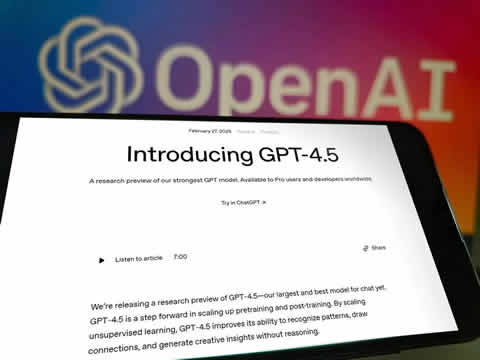GPT-4.5 Launches as AI Competition Heats Up: Efficiency Takes Center Stage
The AI industry witnesses a new milestone with the release of GPT-4.5. With AI competition intensifying, the focus shifts significantly towards enhancing data efficiency. GPT-4.5, developed by leading AI research organization OpenAI, represents a leap forward in the performance and efficiency of generative pre-trained transformers.

GPT-4.5 comes with substantial improvements over its predecessor, particularly in terms of processing efficiency and reduced data consumption. This version is specifically engineered to handle large volumes of data more effectively, reducing operational costs and environmental impacts. Such enhancements align with the growing industry-wide emphasis on sustainable AI development practices.
A fresh wave of large language models are battling for attention. OpenAI’s GPT-4.5, Anthropic’s Claude 3.7, xAI’s Grok 3, Tencent’s Hunyuan Turbo S and the possible early arrival of DeepSeek’s latest model are vying to redefine how we work, communicate, access information and even shape global power dynamics.
At the center of this escalating competition arises a new problem: can AI models become smarter, faster and cheaper at the same time? The emergence of DeepSeek R1 signals that the future of AI might not belong to the largest or most data-hungry models — but to those that master data efficiency by innovating machine learning methods.
ALSO READ
Judge rejects Musk’s attempt to block OpenAI’s for-profit transition
From Heavy to Lean AI: A Parallel to Computing History
This shift toward efficiency echoes the evolution of computing itself. In the 1940s and ’50s, room-sized mainframe computers relied on thousands of vacuum tubes, resisters, capacitors and more. They consume an enormous amount of energy and only a few countries could afford it. As computing technology advanced, microchips and CPUs ushered in the personal computing revolution, dramatically reducing size and cost while boosting performance.
New Models Offer Budget Flexibility
Another crucial enabler of this shift is open-source AI development. By opening up the underlying models and techniques, the field can crowdsource innovation — inviting smaller research labs, startups and even independent developers to experiment with more efficient training methods. The result is an increasingly diverse ecosystem of models, each tailored to different needs and operating constraints.
Some of these innovations are already showing up in commercial models. Claude 3.7 Sonnet, for example, offers developers control over how much reasoning power and cost they want to allocate to a given task. By letting users dial in token usage, Anthropic has introduced a simple but useful lever for balancing cost and quality, shaping future LLM adoption.
Claude 3.7 Sonnet also blurs the line between ordinary language models and reasoning engines, integrating both capabilities into a single streamlined system. This hybrid design could improve both performance and user experience, eliminating the need to toggle between different models for different tasks.
This combined approach also features in DeepSeek’s research paper, which integrates long-text understanding and reasoning skills into one model.

While some companies, like xAI’s Grok, are trained with massive GPU power, others are betting on efficient systems. DeepSeek’s proposed “intensity-balanced algorithm design” and “hardware-aligned optimizations” can reduce computational cost without hindering performance.
This shift will have profound ripple effects. More efficient LLMs will accelerate innovation in embodied intelligence and robotics, where onboard processing power and real-time reasoning are critical. By reducing AI’s reliance on giant data centers, this evolution could also reduce the carbon footprint of AI at a time when sustainability concerns are growing louder.
GPT-4.5’s release marks the intensifying LLM arms race. The companies and research teams that crack the code of efficient intelligence will not only cut costs. They’ll unlock new possibilities for personalized AI, edge computing and global accessibility. In a future where AI is everywhere, the smartest models may not be the biggest. They’ll be the ones that know how to think smarter with less data.
In an ever-competitive field, the upgrades in GPT-4.5 are designed to solidify OpenAI’s position as a leader in the AI space. This release not only addresses the ongoing need for faster and more reliable AI models but also sets a new benchmark for future developments in the sector.
The shift to more data-efficient technologies in AI tools like GPT-4.5 highlights the industry’s response to calls for more responsible technology use, balancing innovation with sustainability. As AI technologies continue to evolve, the focus on efficiency is likely to play an increasingly crucial role.

